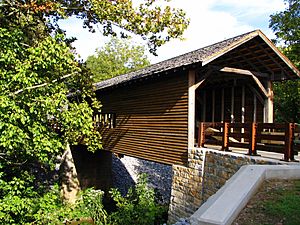Harrisburg Covered Bridge facts for kids
Quick facts for kids Harrisburg Covered Bridge |
|
|---|---|

Harrisburg Covered Bridge (2006)
|
|
| Coordinates | 35°51′39″N 83°28′57″W / 35.860943°N 83.482549°W |
| Crosses | East Fork Little Pigeon River |
| Locale | East of Sevierville (Tennessee) |
| Characteristics | |
| Design | King post truss covered bridge |
| Width | 88 feet (26.9 m) |
| Longest span | 64 feet (19.5 m) |
| History | |
| Construction end | 1875 |
| Statistics | |
| Daily traffic | 20 |
|
Harrisburg Covered Bridge
|
|
|
U.S. Historic district
Contributing property |
|
| NRHP reference No. | 75001777 |
| Added to NRHP | June 10, 1975 |
The Harrisburg Covered Bridge is a special historic bridge in Sevier County, Tennessee, in the United States. People also call it the Pigeon River Covered Bridge, East Fork Bridge, or McNutts Bridge. You can find it east of Sevierville, just off U.S. Highway 441. This bridge is a type called a king post truss design. It crosses the East Fork of the Little Pigeon River.
Contents
Building the Harrisburg Bridge
Before the Harrisburg Covered Bridge was built in 1875, there was another bridge in the same spot. It was called the McNutts Bridge. Sadly, a big flood washed that bridge away.
In March 1875, local leaders in Sevier County decided they needed a new bridge. They asked a group of people to plan and build it. The people living nearby helped out a lot. They gave money, building materials, or worked as helpers. This was a common way to build things back then.
Elbert Stephenson Early (1850–1917) was chosen to lead the building of the new bridge. His family had moved to the area in the 1870s. Many of them were skilled builders, like carpenters and engineers.
Life Around the Bridge
In the late 1800s, the area around Harrisburg grew a lot. Life was busy and exciting because there were many local mills and workshops. The Harrisburg Bridge was important for people to cross the river and get around.
However, after 1915, a new road was built that went around Harrisburg. Because of this new road, the community slowly became smaller. Many people moved away from the area.
Keeping the Bridge Strong
Over the years, the Harrisburg Covered Bridge needed some care to stay strong.
In 1952, workers added a concrete pillar to help support the bridge. This made it much more stable.
By the 1970s, the bridge was in bad shape. Some people thought it should be taken down. But a group called the Daughters of the American Revolution stepped in. They raised money to fix the bridge. This group also asked for the bridge to be added to the National Register of Historic Places. This happened on June 10, 1975, which helped protect the bridge.
In 1983, the bridge was repaired again. After this, a sign was put up saying that vehicles crossing the bridge could not weigh more than three tons.
More repairs were done in 2004. After these fixes, the weight limit for vehicles was increased to 15 tons. This meant heavier cars and trucks could use it. As of 2010, about 20 vehicles crossed the bridge each day.
Bridge Measurements
The main part of the bridge, called its span, is about 19.5 meters (64 feet) long. The total length of the bridge is about 26.9 meters (88 feet). Inside, the bridge is about 3.2 meters (10.5 feet) wide. The sides of the bridge are partly made of tinplate.

